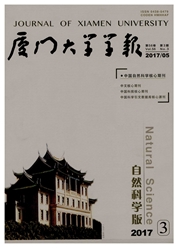

 中文摘要:
中文摘要:
为深入了解接触辉光放电等离子体降解水中有机污染物的机理,用紫外-可见吸收光谱法研究了放电过程中染料结构的变化,考察了pH值、自由基清除剂等实验条件对艳红B脱色的影响.结果表明:加入羟基自由基清除剂可增强艳红B的脱色效果,加入氢自由基清除剂对艳红B的脱色有轻微的阻碍作用.溶液初始pH值在7.0~11.0之间时对脱色影响不大.随着反应的进行,溶液的化学需氧量逐渐升高.紫外-可见吸收光谱分析表明,等离子体产生的活性氢原子对偶氮键的破坏是艳红B脱色的主要原因.
 英文摘要:
英文摘要:
To probe the mechanism of brilliant red B degradation by contact glow discharge plasma in water,changes in dye structure during the treatment were studied by UV-Vis spectrometry,and the influences of initial pH and radical scavengers on the bleaching were examined.Experimental results showed that addition of tert-butyl alcohol enhanced while addition of H2O2 slightly inhibited the brilliant red B bleaching.Initial pH had little effect on the bleaching rate in the range from 7.0 to 11.0.Chemical oxygen demand of the solution increased gradually with increasing treatment time.UV-Vis spectra analyses showed that the reactive hydrogen atoms produced by plasma were the most likely species responsible for the azo-bond destruction and bleaching.
 同期刊论文项目
同期刊论文项目
 同项目期刊论文
同项目期刊论文
 Characteristics of Light Emission and Radicals Formed by Contact Glow Discharge Electrolysis of an A
Characteristics of Light Emission and Radicals Formed by Contact Glow Discharge Electrolysis of an A Enhancement of Phenol Degradation by Electron Acceptors in Anodic Contact Glow Discharge Electrolysi
Enhancement of Phenol Degradation by Electron Acceptors in Anodic Contact Glow Discharge Electrolysi Determination of Lithium ion with Liquid-phase Diaphragm Glow Discharge-Atomic Emission Spectroscopy
Determination of Lithium ion with Liquid-phase Diaphragm Glow Discharge-Atomic Emission Spectroscopy 期刊信息
期刊信息
